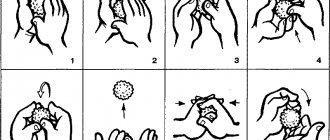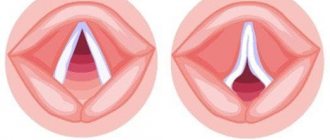Reasons for difficulties in pronouncing the sound “l”
Most sounds are perfectly mastered by a child by the age of 4-4.5 years.
If you notice that your baby is having difficulty pronouncing several letters or one “l” sound, look for the reasons. One of the factors may be a speech defect in an adult who is in constant contact with the baby. The child imitates the speech of mom or dad.
Pronunciation problems have also been observed in children growing up in bilingual families. It is difficult for a child to master two languages at once; he gets confused and replaces the sounds of one language with the sounds of another.
Among the physiological reasons we note the following:
- disorders that arise during the development of speech hearing (the child hears sounds incorrectly);
- pathologies of the hearing aid and speech breathing;
- changes in the structure of the articular apparatus (in the case of the sound “l” this may be a shortened frenulum).
All anatomical changes are determined by a specialist. Self-diagnoses often lead to incorrect treatment and worsening of the defect.
If your child is diagnosed with a shortened frenulum, there is no need to worry. For a long time, the defect was corrected using an incision, but today a new technique has been developed in which the frenulum is stretched to the required size using special exercises.
What is lambdacism and paralambdacism?
Incorrect pronunciation of the sound “l”, “l” or its complete absence has a scientific name - lambdacism. It is divided into 4 types:
- nasal. The sound coming out with the air flow tends to enter not through the mouth, but through the nose. This occurs when the root of the tongue pushes against the roof of the mouth, obstructing the passage. In such cases, instead of “l”, it turns out “ng lapa-ngapa, lak-ngak;
- bilabial. The child puts his lips in a tube, so that instead of the prescribed “l”, the result is “u”: doctor-whecker, lamp-uampa;
- interdental. The tip of the tongue gets into the space between the teeth, producing an incorrect sound;
- lack of "l". One of the most common options. The baby does not pronounce “l” at all; instead, words without it are obtained: Luk-uk, lens-inza.
What lambdacism is is now clear, but what then is paralambdacism. This includes replacing “l” with other sounds. Such replacements include:
- replacing “l” with the sound “v” or “b”: lala - woman, lava-vava, moon-wuna;
- replacing “l” with “g”: gog-gog, table-stack;
- replacing “l” with “d”: horse-horse, lupa-dupa;
- replacing “l” with “ya”, “yo”, “yu”: lader-yager, spoon-hedgehog, bow-yuk;
- replacing “l” with a soft “l”: doing-sharing.
Caution: physiological dyslalia
But by the age of four you need to be on your guard: the time for correct speech comes, and the baby simply does not know how to pronounce some sounds. And if you leave it to chance, and don’t teach him to speak correctly in time, you can make your child the subject of mockery and ridicule for the rest of his life. And he will probably have problems with spelling. Along with the difficult consonant “R”, many children do not know how to pronounce the letter “L”.
This speech defect is called physiological dyslalia in speech therapy and is quite common among children from four to six years old.
Types of pronunciation disorders
Over time, many people themselves can learn to speak correctly. This is how a child can distort the letter "L".
- The baby does not hear this sound and completely misses it: instead of “ruler” he says “frost”.
- “L” is replaced by the sound “U” or “V”: “spoon” - “oozhka”; "Larissa" - "Varisa". At the same time, children try to pronounce “L” not with the tip of their tongue, but with their lips
- Instead of “L” it is pronounced “Y”: “hammer” - “myotok”
- The child confuses the hard and soft letter “L”.
Before contacting a speech therapist, it is useful for parents to become familiar with the rules of pronunciation of the sound L and teach them to their child. Perhaps after home lessons he will begin to say this sound correctly.
Recommendations for parents
Before moving on to exercises with the letter L, adults need to learn a number of simple rules that will make classes easy and spending time with your child enjoyable:
- Speak as equals. Don't try to make things easier by babying, you'll only make things worse. Pronounce all words correctly - this is an extremely important condition.
- Answer questions. If your child doesn’t understand something, stop and explain in more detail. This way your baby will feel strong support, and you will gain his full trust.
- Turn activities into games. Children learn information well through play. It is important that the exercises evoke a positive emotional response in the baby. Make up fairy tales and arrange unusual adventures. Under such conditions, the child will begin to pronounce the sound L reflexively.
- Exercise shouldn't be a punishment. In this way, you will discourage your child from wanting not only to study, but also to communicate with adults.
- Maintain regularity. Conduct classes systematically, at a time that is comfortable for you and your child. The ideal option is exercise for 5-10 minutes 3-4 times a day.
By following these simple recommendations, your child will quickly learn to pronounce the letter L at home.
Formation of correct pronunciation of sounds
If the child does not suffer from diseases or pathological developments of the speech apparatus, then adults can quickly solve the problem. To understand how to make the “l” sound at home, you should follow a few simple rules.
- Work should begin with strengthening articulatory motor skills. Its strengthening is achieved through exercises and games.
- The next stage is sound production. The methods are different. There is a method for each case.
- The production of sound flows into pronunciation. When the student has learned to pronounce the letter, he must move on to syllables, and then to simple words and sentences with many repeating sounds.
- Let's move on to more labor-intensive work. We learn rhymes and tongue twisters. A preschooler will learn sounds faster and develop memory.
- Results should be consolidated through telling and repeating fairy tales, short stories, poems, stories, and singing songs.
Sound correction [l] at home
Speech disorders occur for various reasons. In the case where the child does not speak only one or two sounds, parents can try to correct the defect themselves.
Classes with a speech therapist will help correct any speech problems
How to teach a child to say the letter L hard
With dyslalia, children have problems only with sound pronunciation. Violations arise due to structural features of the articulatory apparatus or insufficient muscle preparation.
For the sound [l], the upper rise of the tip of the tongue is important. This is difficult to do with a short hyoid frenulum. Therefore, it must first be trimmed by a dentist. Only surgery will solve this problem.
It’s easy to check the ligament: you need to ask the child to touch the upper teeth with the tip of his tongue. Sonoras ([l], [r] and their soft pairs) appear by the age of five and until that time there is nothing to worry about. At three years old, the child’s articulatory apparatus is still developing.
Important! There is no need to rush and demand that children pronounce all sounds from an early age. Otherwise, you can provoke the development of a defect.
At home, you can try to correct the incorrect pronunciation of the sound [l] yourself. This is only allowed in the case of dyslalia. Sometimes this problem can be confused with dysarthria, which requires work with a speech therapist.
With dysarthria, the mobility of the muscles of the articulatory apparatus is impaired. A similar problem is expressed in hypertonicity or hypotonicity. Often the tongue of such a child is bunched up in the mouth or is too relaxed. It will be difficult for your baby to perform fine movements and switch from one position to another.
Correcting incorrect pronunciation may take up to one year. You need to work with your child every day - this will speed up the process. It is necessary to follow the sequence of stages and not rush.
Sound production
The mechanical method is often used in speech therapy. It requires a special probe in the form of a wire frame or a spatula. The child opens his mouth wide, pronounces “YYYYYY” in a drawn-out manner, and at this time the adult lifts his tongue with an instrument.
It is easier to teach a child to pronounce a sound from the interdental position. To do this, the preschooler is asked to bite the tip of the tongue and pronounce the sound [s] (YYYYYYY), and then gradually remove the tongue behind the upper teeth.
You can pronounce [l] in the interdental position immediately with syllables. Gradually we are moving away from this situation. Automation begins only with direct syllables: LA, LO, LY, LE.
Important! You cannot rush to move on to words, otherwise defective pronunciation will become entrenched.
Programs for speech development in preschool educational institutions in accordance with the Federal State Educational Standard
Sound Automation
After the correct pronunciation has been worked out in forward and backward syllables, they move on to words. To facilitate perception, visual material is used in the form of pictures and special games. For example, a child is asked to show objects with the sound [l].
Syllables can be pronounced using a probe
It is difficult to teach a preschooler to exercise self-control. Therefore, you need to constantly work with him. It is enough to devote less than half an hour to work and the effect will not be long in coming.
Parents should understand that there is no method that will give quick results. Only constant training will help you consolidate correct pronunciation.
Songs and rhymes
To facilitate the automation process, different lexical material is used. Pure sayings and poetic forms are easier to remember and the child likes to reproduce them.
You can talk to a preschooler about different topics. This will make it easier for him to get used to the correct pronunciation.
Example of poems for sound automation [l]
The main condition for effective classes is the interest of the student. Therefore, everything is carried out in a playful way. The more varied the material, the better for the baby.
Tongue Twisters
The most difficult thing is to introduce sound into independent speech. To facilitate the process, tongue twisters using the sound [L] are used. They contain words that allow you to practice sound pronunciation in different positions.
For example, “There are pins at the Christmas tree”, “Will in the field”, “I went to Luka’s tray, Luka bought onions from the tray”, etc. Gradually, the child is asked to pronounce each tongue twister faster. Much attention is paid to correct pronunciation.
Articulation exercises
Learning to pronounce a sound correctly begins with articulatory gymnastics. Speech therapy exercises for quickly setting sound [l]:
- The wide tongue lies behind the lower teeth, the child pronounces “YYYYYYYY” in a drawn-out manner.
- Lick your upper lip with the tip of your tongue.
- Click your tongue.
- Open your mouth wide and run your tongue along the inside of your teeth.
- Run the tip of your tongue across the roof of your mouth.
The complex is performed every day. In order for a child to learn to pronounce a sound correctly, he must do all the exercises correctly. In this case, it is important to monitor the immobility of the jaw.
Articulation gymnastics is performed strictly in front of a mirror
After all the movements are easy to perform, move on to the next stage - producing a solid sound [l]. To do this, different techniques are used. It is impossible to say in advance which one will suit a particular child.
How to make the sound "l"
The very first thing to start with is to tell and show the student the correct pronunciation of the sound, and how the tongue and lips behave. There are many free photos and videos available online for this purpose. Many methodological works have been developed on how to teach a child to say the letter “l”. To put an "l" you need to work on your breathing and articulation.
At home, you yourself can explain how to correctly pronounce this or that sound. Just think about how you do it, and then show it. Children always learn better from the example of others. Just show the principle and let the child repeat after you.
Problems with speech production in children are common. The lessons will help the child develop auditory perception of the sound “l”.
It is important to breathe correctly and position your tongue and lips. Breathing exercises are designed as a game.
The simplest exercises will be interesting to the baby. Having fun outside can be educational. While walking, you can play with dandelions, offering to blow off all their “feathers” and blow soap bubbles.
At home you can play with a lit candle, blowing it out, or a match, but only under the strict supervision of adults, and various similar games for blowing air. Such games will interest your baby and will at the same time be educational in nature.
It is necessary to develop the child’s fine motor skills. It is necessary for speech correction, intellectual and physical development.
Preparing for “L” positioning exercises
There are articulatory gymnastics that help to place the “L” and facilitate the process of making the sound later. In general, exercises help increase the mobility of the lips and tongue:
- “Hammock” - the tip of the tongue rests on the front incisors of the upper row. It should be bent down so that the shape resembles a hammock sagging down. There is no need to perform any movements here - just hold your tongue in this position for a while. It's better to do a counting exercise.
- “Delicious” - you need to make your tongue wide, and then lick your upper lip with it from top to bottom. It is important that the tongue works independently - the lower lip should not move upward, thus moving the tongue. It’s easier to do the exercise this way, but it’s wrong.
- “Turkey” - the position of the tongue, as well as the movements performed, coincide with the “Tasty” exercise. In this case, you need to significantly speed up the pace of movements and add to this the pronunciation of the sound “bl-bl-bl” or similar.
- “Horse” (helps if it is difficult to hold the tongue suspended by resting it on the front teeth): the tongue should be made wide, and then click it on the palate near the upper front teeth. The lower jaw should not move in any way, and the mouth should be slightly open.
- “Swing” - in a wide smile you need to open your mouth slightly. The exercise is performed by counting - for “one” you need to rest the tip of the tongue on the upper teeth from the inside, for “two” - on the lower ones. The exercise is performed alternately.
- “Mushroom” (helps to fix the tongue on the palate, that is, in the position from above): the surface of the tongue from above must be rested against the palate so that the tension of the lingual frenulum is felt. There is no need to perform any movements.
Such exercises are effective for any type of lambdaism. Before starting training directly “L”, these exercises must be performed for at least 14 days (sometimes such training is continued for a whole month). After this, you can begin to do speech therapy exercises on the sound that is necessary.
Training the sound “L” by imitation
If a child does not pronounce a sound, it will be easier to introduce it, because when replacing a correct sound with an incorrect one, a habit is formed, and it can be much more difficult to correct it.
Correct articulation
Articulation gymnastics will help correct incorrect pronunciation of sounds. It is necessary to train the tongue, stretch the frenulum, and stretch the baby’s lips and cheeks. All this will prepare his speech apparatus for clear and firm pronunciation of words.
Basics of correct articulation:
- lips stretched in a smile, teeth slightly covered. The tip of the tongue rests on the upper central incisors or gum;
- mastering speech breathing: the child makes a sound, a strong stream of air goes around the tongue and comes out of the mouth. This is an important point. Speech occurs while exhaling, so improper air distribution greatly distorts pronunciation. Playing with soap bubbles helps develop breathing. It is important that the baby takes air into the lungs, and not into the cheeks;
- vocal cords are closed. Place your palm against your throat: when pronouncing the sound [L'], vibration will be felt.
Children are big fans of making faces, you can use this when teaching your child how to pronounce the letter “L” correctly:
- smile . Ask the baby to smile widely without opening his lips. You need to hold out for 8-10 seconds. Repeat the exercise 6-7 times a day;
- horse _ The baby tries to imitate the clatter of hooves. Let the child smile with his mouth slightly open, and in this position click his tongue, first slowly, then faster and faster. Only the tongue should work, the lower jaw does not move;
- painter _ The tongue strokes the palate, as if painting it. Movements: from the teeth and deep into the mouth;
- swing . Alternately push the upper and lower teeth with the tip of your tongue, gradually increasing the pace. You need to do 6-8 repetitions. The purpose of the exercise is to learn how to quickly change the position of the tongue. This skill is useful for mastering syllables where the letter “L” is combined with vowels: “la”, “lo”, “il”, “ul”, etc.;
- jam . The mouth is slightly open. The baby licks his upper lip with his tongue: up and down. The lower jaw should not move. If the exercise does not work, then first you need to teach the baby to keep a relaxed, protruding tongue on his lower lip. You can offer to compete with the baby to see who can hold this position longer. Then the tongue can be raised, touching it to the upper lip;
- tube _ Roll your tongue into a tube as tightly as possible;
- brushing teeth . Move your tongue along the inside of the upper row of teeth: from right to left and back;
- breeze _ The mouth is slightly open in a smile. The child bites his tongue and blows out air. 2 jets should form. To check the correctness of the exercise, you can bring a feather or ribbon to your mouth, this will stimulate and diversify the child’s activity;
- steamship whistle . The baby opens his mouth and pronounces the sound [Y'] for a long time. In this case, the tip of the tongue is lowered and located in the depths of the mouth, and its back is raised to the palate;
- fungus _ It is performed by pressing the tongue firmly against the palate.
All exercises are carried out together in front of a mirror: the baby must see the parents’ movements and repeat them. The purpose of the classes is to develop tongue mobility and correctly regulate the air flow as you exhale.
How to make correct pronunciation automatic
Once the correct pronunciation has been established, it needs to be reinforced. This process is difficult and time consuming for children. At home, it is enough to practice a few minutes a day in the morning and evening. It will be better if the lessons take the form of a game.
Soft L
The child often misses the soft L and even entire syllables with its participation. Therefore, it is better to start speech therapy exercises for sound from this moment.
To begin with, the pronunciation of syllables is fixed. Then you can move on to words. Individual syllables can be reinforced using special tongue twisters.
Examples are given in the table
| The syllables are simple | Complex syllables | Example words | Tongue Twisters |
| La | Blah, blah, blah, blah, blah | Fields, Kolya, Tolya, poplars | La-la-la - cold earth |
| Liu | Slue, peck, spit, flu, glu | Lucy, buttercup, hatch | Lu-lu-lu - I light the stove |
| Lee | Sli, kli, pli, fly, glee | Lida, linden, fox, lemon | Li-li-li - found a lemon |
| Le | Sle, cle, ple, fle, gle | Lena, laziness, forest | Le-le-le - everything is in ash |
| Le | Sle, cle, ple, fle, gle | Flax, light, bag |
When the child begins to develop straight syllables, you can move on to reverse ones. First, individual sound combinations are worked out, then they move on to whole words and tongue twisters.
| Simple syllables | Example words | Tongue Twisters |
| Al | Coat, tracing paper | |
| Spruce | Drops, jelly | Spruce-spruce - drops outside the window |
| Ol | Mole, salt | Ol-ol - a moth flew in |
| Uhl | Glug, glug, glug | Ul-ul - hung tulle |
| Eul | Dust, soap | Eul-eul - palms soapy |
| Yul | July, tulle |
Solid L
It is somewhat more difficult to teach a child to say hard L. To automate the sound, the same techniques are used as for soft ones. But it may take more time to consolidate.
Exercises to improve speech hearing
To develop speech hearing, speech therapists recommend playing games with your child:
- They suggest speaking the words first quietly, then with medium force, then loudly. You can show toys and give tasks - a small toy speaks quietly, a large one speaks loudly, then vice versa.
- They read fairy tales by role, where the characters speak in different voices - quietly or loudly, in a low or high voice.
- The child is shown pictures and named them. Some names are misspelled. If the player notices a mistake, he raises his hand or claps his hands.
- An adult shows a picture and says several similar words. Among them you need to choose one correct one (bow - meadow - hatch).
- The parent or teacher names a generalizing word. Children are asked to name examples of words from the named group. They should contain the letter L (fruits - lemons, apples, trees - maple, linden, etc.).
Training must be carried out systematically. Game activities can be supplemented with musical accompaniment.
When to contact a speech therapist?
By the age of 4, the sound L is easy for the child, he begins to correctly pronounce words with this letter. However, for a number of reasons, kids can distort words:
- forget, skip or not hear “L” (instead of “spoon” says “ozhka”);
- change “L” to “U” or “V” (“lamp” - “uampa”, “Larissa” - “Varisa”);
- instead of “L” say “Y” (“kolobok” - “koyobok”);
- confuse soft and hard “L”.
These errors usually resolve on their own or after a few practice sessions at home. In cases where a child’s speech defect is accompanied by malocclusion or a neurological disease, you should consult a specialist. An experienced speech therapist will prescribe an effective training program and help the child pronounce words correctly.
Why does a child pronounce a sound incorrectly?
The sound [L'] is considered complex and is the last to be mastered by the baby.
If by the age of 5 speech disorders persist, then perhaps the reason lies in the following situations:
- someone close to you pronounces “L” incorrectly, and the baby imitates him;
- poor phonemic awareness. A 3-5 year old child can already distinguish all types of consonants by ear: hissing, voiceless, voiced, etc. Even when he cannot pronounce them correctly, he must correctly indicate the mouse or bear in the picture. If the baby has undeveloped phonemic hearing, in the future there will certainly be difficulties with writing and reading. You need to be able to distinguish all sounds by the age of 4;
- the family speaks 2 languages. This is always a risk for the development of speech disorders. In this situation, it is considered normal if both languages are acquired with a slight delay;
- short frenulum of the tongue. Normally, for 5-6 year old children, its length should be 8 cm. If a shortening or thickening of the frenulum is detected, then there will definitely be difficulties with the pronunciation of “L”. The problem can be solved either surgically or conservatively with the help of articulatory gymnastics.
A consultation with a speech therapist or dentist will help you find out the cause of incorrect pronunciation.
Experts note that only 10% of children aged 4-5 years can clearly pronounce the sound [L'].
The feasibility of speech therapy classes
Some parents do not think about how to teach their child to say the letter L. They do not consider the defect to be something serious, but in adult life it will become the basis of complexes and worries.
Important! It is better to correct speech disorders in preschool age, then the process will take a little time.
Causes, diagnosis and clinical picture of mental retardation in ICD 10 coding in children
If parents do not know how to correctly teach their child to pronounce the letters L and R, then they should contact a specialist. A speech therapist will be able to correct this problem and develop the desired pronunciation.
How many lessons does it take to produce sound [l]
It is impossible to say with certainty how many lessons will be required to eliminate the defect. Sometimes sound production takes one session, in other situations it will take more than 30-40 meetings.
It all depends on the characteristics of the child, his motivation and the interest of the parents. Learning to pronounce the sound [l] is not so easy, since a preschooler gets used to a certain stereotype. Due to their age, it is still difficult for children to perceive learning activities.
Articulation gymnastics
Exercises that increase the mobility of the tongue and lips will help you quickly learn how to correctly pronounce various sounds, and this applies not only to one letter “L”.
L sound articulation profile
- Smile. It is important to remember that you must pronounce the sound “L” with a wide smile. We try to teach the baby to smile from ear to ear with his mouth closed and hold the resulting grimace while counting to 10.
- Breeze. This exercise can teach a child to exhale air correctly while pronouncing the sound “L”. We bite the tongue and blow with all our might through the side holes between the teeth, simulating a hurricane. We don’t puff out our cheeks.
- Yummy. We lick our lips with our tongue in a circular motion; With this exercise, the child trains his tongue to correctly pronounce various sounds.
- Horse. Smiling widely and showing your teeth, imitate the clicking of a horse, first loudly, then more and more quietly, leaving the lower jaw motionless.
Speech therapy exercises for L articulation - Steamboat. We hum in a bass voice, like a steamboat, with the tip of the tongue remaining behind the teeth and the back raised to the sky: “y-y-y”
- Comb: close your teeth and push your tongue between them, as if combing it. This exercise can teach you to quickly take the tongue into the desired position when pronouncing the difficult sound “L”
- Swing your tongue in your mouth, resting it first on the right cheek, then on the left.
Today, researchers have proven that fine motor skills of the hands are directly related to speech, so modeling, finger games, and small toys for a baby are necessary to learn to speak correctly.
The development of hand motor skills helps develop speech.
If, after many efforts, the child still cannot pronounce the letter “L” correctly, it is necessary to contact a speech therapist. Perhaps it is a malocclusion, a neurological disease, or stress. It is important to remember that the age from 4 to 6 years is the most favorable for learning correct speech; later it will be necessary to eliminate the ingrained skill, and this is more difficult to do.
Subscribe
Detki.guru on Telegram
Leave a comment











